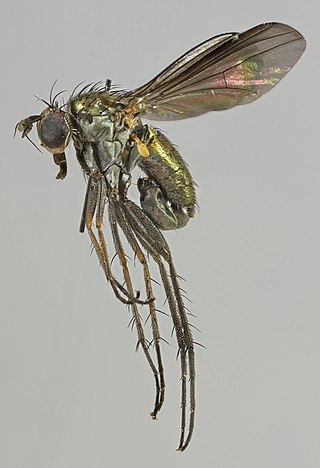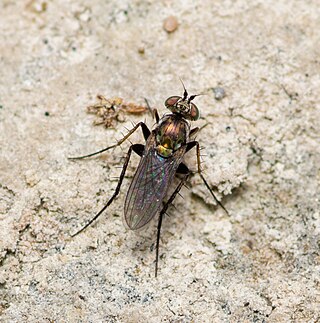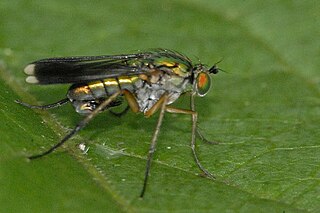
Hercostomus is a genus of flies in the family Dolichopodidae. It is a large genus, containing more than 483 species worldwide. Multiple studies have shown that Hercostomus is a polyphyletic assemblage of species.
Anasyntormon is a genus of flies in the family Dolichopodidae. It was originally placed in the subfamily Rhaphiinae near Syntormon. It was transferred to Dolichopodinae by Hans Ulrich (1980), who found it to be congeneric or closely related to Hercostomus.
Keirosoma is a genus of flies in the family Dolichopodidae. It is distributed in the New World. The subfamily has variously been placed in the Rhaphiinae, Diaphorinae or Sympycninae. According to Scott E. Brooks in 2005, the systematic position of the genus is still uncertain, though a possible relationship with Pseudohercostomus has been suggested.

Lichtwardtia is a genus of flies in the family Dolichopodidae. It is known from the Afrotropical, Oriental and Australasian realms. It can be recognised by its zigzag-shaped M vein on the wings, and its feather-like hairs on the apex segment of the antennae. In a phylogenetic analysis of the subfamily Dolichopodinae by Scott E. Brooks in 2005, Lichtwardtia is considered to be a synonym of Dolichopus, but subsequent authors have retained it as a valid genus.
Metaparaclius is a genus of flies in the family Dolichopodidae. It is known from Papua New Guinea and Australia. The systematic position and monophyly of the genus are currently ambiguous: the holotype specimen of the type species, Metaparaclius subapicalis, was deposited in the Hungarian Natural History Museum, which was destroyed during the Hungarian Revolution of 1956, and no other specimens of this species are currently known.
Muscidideicus is a genus of flies in the family Dolichopodidae. It contains a single species, Muscidideicus praetextatus, which is found only in the Western Palaearctic.

Paraclius is a genus of flies in the family Dolichopodidae. It is currently considered a polyphyletic assemblage of species.
Pseudohercostomus is a genus of flies in the family Dolichopodidae. It is distributed in the Oriental and Afrotropical realms as well as Chile.
Stenopygium is a genus of flies in the family Dolichopodidae. It contains two species which are found in the Neotropical realm, and is related to Pelastoneurus.

Sybistroma is a genus of flies in the family Dolichopodidae. It includes over 50 species, described mainly from the Palaearctic and Oriental realms. A single species is known from the Afrotropical realm. Until 2005, the genus was thought to be restricted to the Mediterranean in distribution, with five known species. It was recently expanded to include the former genera Hypophyllus, Ludovicius and Nodicornis, as well as some species of Hercostomus.
Vetimicrotes is a genus of flies in the family Dolichopodidae. It is distributed in the Palaearctic realm. The genus was originally named Microtes by Theodor Becker in 1918. Afterwards, the name was found to be preoccupied by the grasshopper genus Microtes, so it was renamed to Vetimicrotes by C. E. Dyte in 1980.

Dolichopodinae is a subfamily of flies in the family Dolichopodidae.
Aphalacrosoma is a genus of flies in the family Dolichopodidae, known from China and Taiwan.
Platyopsis is a genus of flies in the family Dolichopodidae. It contains a single species, Platyopsis maroccanus, from Morocco and Algeria. According to a cladistic analysis by Brooks (2005), the genus appears closely related to Stenopygium and Pelastoneurus.
Allohercostomus is a genus of flies in the family Dolichopodidae. It includes three species from China and Nepal. Members of the genus are metallic green in color and are small in size, with a body length of 2.5–3.2 mm and a wing length of 2.8–3.4 mm. The generic name is a combination of the prefix allo- with the generic name Hercostomus. In Brooks (2005)'s phylogenetic analysis of the subfamily Dolichopodinae, Allohercostomus was hypothesized to be the most basal member of the subfamily based on a triangular depression present on the scutum in front of the scutellum, a plesiomorphy lost in other members of the subfamily. It can also be distinguished from other members of Dolichopodinae by features such as the bottoms of its eyes being contiguous.

Gymnopternus is a genus of flies in the family Dolichopodidae. It was formerly placed as a subgenus of Hercostomus, but is now accepted as a separate genus.
Parahercostomus is a genus of flies in the family Dolichopodidae. It includes four species known only from China. Members of the genus are metallic green in color and large in size, with a body length of 4.5–5.3 mm and a wing length of 5.2–7.0 mm. The generic name is a combination of the prefix para- with the generic name Hercostomus. According to Brooks (2005)'s phylogenetic analysis of the subfamily Dolichopodinae, Parahercostomus appears to be closely related to Grichanov (1999)'s Afrotropical species group 1 in the genus Hercostomus, which was later transferred to the genus Afrohercostomus.

Poecilobothrus is a genus of flies in the family Dolichopodidae.
Setihercostomus is a genus of flies in the family Dolichopodidae, known from China, Taiwan, Russia and Tanzania.






